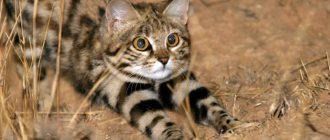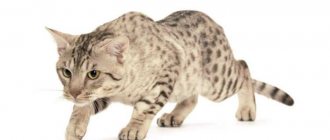Believe it or not, there are cats in the world who are not afraid of water! This is a civet fishing cat, a rather rare animal. Such a cat will not run away from the lake, but, on the contrary, will frolic in it with great pleasure. And how could it be otherwise? After all, it is in reservoirs that they get their food.
The civet fishing cat lives mainly in wet swampy areas in the wild, and whenever possible tries not to meet people. And people themselves are not frequent guests in such places, but just in case, the cat, due to the color of its fur coat, successfully camouflages itself and blends harmoniously into nature.
Today, there are more and more people who want to place some exotic animal next to them. Moreover, they sincerely believe that a wild animal, if taken into the house when it is very young, will definitely grow up to be a kind and well-mannered pet. And there are enough people who want a civet fishing cat to live under the same roof with them.
It would be useful to get to know this breed of cats in more detail, learn about their character, habits, and whether they are suitable for keeping at home.
Appearance
The civet fishing cat is a large predator, although it weighs less than a panther and a leopard. The weight of an adult cat reaches 10 kg, and that of a cat – 15 kg. The length of the animal, including the tail, is 1 m 20 cm, but the tail accounts for only one quarter of the total length of the fishing cat, no more. The tail itself has the same thickness from base to tip. The cat's physique, like that of any other real predator, is muscular and squat. The paws are thick and short, but strong, thanks to them the fishing cat defeats opponents larger than himself in a fight. In general, this animal is very graceful, has great strength and the swiftness of a leopard.
The fishing cat's muzzle is slightly elongated. The head is wide and large, and the neck is very short, and therefore the head seems to immediately merge into the body. The head is crowned with movable small rounded ears. They are pressed to the head and because of this they give the cat’s appearance aggression. The cat's eyes are large, with a vertical pupil. You can feel absolute confidence in your abilities in your gaze. You may hear about fishing cats as “the pit bull of the cat world” - this is what they are called because of their very strong jaws. But the most important thing that distinguishes the civet fishing cat from cats of other breeds is its unusually shaped nose. It is very wide and large, there is practically no bridge of the nose. This nose structure helps the cat well in hunting when it swims and dives. The cat takes a deep breath and holds its breath, but no water gets into its nose.
The fur of the civet fishing cat is hard and short, but waterproof. The coat color is olive-gray, matte, with black spots and stripes arranged in a row. This color is perfect for a cat, as it can easily blend in with the vegetation in its habitat.
How do fishing cats get food?
This animal leads a twilight and nocturnal lifestyle, and during the day it sleeps in the grass or bushes. He is not a fan of climbing trees, but he loves to fish. In the process of catching fish, the civet fishing cat wanders through the shallow water and picks up fish with its strong paws with very sharp and large claws. His movements are lightning fast.
Also, when hunting on water, a cat can resort to cunning: keeping its body completely motionless, it lightly touches the water, imitating the movements of insects. The fish are interested in such movements, it swims to the surface, where the cat grabs it.
But these cunning predators fish not only in shallow water; they feel no worse in the depths. They can easily cover long distances in water. And all thanks to the membranes present between the claws on the paws. Because of the membranes, it is more difficult for the animal to retract its claws, but they are the main assistants in catching fish. The civet fishing cat can dive in the water when chasing prey. At the same time, it presses its ears very tightly to its head, thereby protecting itself from water getting into them. As it turns out, cats have many different techniques that they use when catching fish.
For entertainment, these animals search for snails and frogs in shallow water. A very fun way to entertain yourself.
The civet fishing cat feeds on what it catches: crayfish, snakes, fish. On land it catches insects, birds, and, less commonly, mammals no larger than a lamb.
Is it possible to keep a civet cat at home?
Through their activities, people are slowly but surely destroying places suitable for the life of these cats: they drain swampy areas of the area, cut down forests so that they become suitable for agriculture, expand existing human settlements and build new ones. The result of all these actions is the deterioration of living conditions for the civet fishing cat, which only contributes to the extinction of these unique animals in the near future.
Breeding these felines is prohibited in almost all countries of the world. And due to the complex nature of the animal, people who decide to purchase it may have a lot of problems. More than one generation of predatory cats living in the natural environment often comes into conflict even with similar fishing cats, not to mention other inhabitants of the wild environment.
There are no guarantees that a fishing cat, who came into the family as a small kitten, will not have conflicts with its owner when it becomes an adult. A cat will need a special approach, so in matters of education it is better to seek help from specialists who know everything about keeping it at home. They will be able to give useful advice and all the necessary knowledge.
Black-footed cat: description
African wild cats are not cute furry cats from cartoons. They are capable of terrifying even people, let alone small animals. One of the wild inhabitants of Africa is the African black-footed cat. A cute, cute animal lives in deserts and looks like a pet, although, unlike the latter, it has a far from peaceful disposition and tries very hard not to catch the eye of a person. Yes, the creature's appearance is very deceptive. The African black-footed cat is not a harmless creature, but a very dangerous and brave predator. The Aborigines are afraid of the beast and have long made up legends about it. It is worth noting that the cat is the smallest representative of wild cats. It is also called the ant tiger. This nickname speaks for itself.
Rules for keeping a cat at home
Every year there are more and more nurseries for breeding civet fishing cats, and professional breeders are not afraid of the difficulties in obtaining permission to raise these exotic animals. Exotic lovers should purchase animals only from one of these nurseries. And after you have adopted a kitten, follow a number of rules for its care.
The ideal age for a kitten to be placed in a home is two months. As soon as the kitten was brought into the house, from the very first days of its life it must be fed by hand, so that it gets used to both the new home and its owner. The kitten should be with people all the time. Often people who have houses outside the city set up something like an enclosure on their property and place a kitten there. In this case, the animal will never truly get used to people and, alas, will not become pets.
The civet fishing cat, like any domestic animal, expects attention and affection from its owner. He also loves to play madly, but, being carried away by the gameplay, he may, without meaning to, scratch or even bite his owner. Under no circumstances should a cat be scolded, let alone beaten for this, because he will immediately defend himself. It is enough to simply strictly tell the cat “no” and blow in his face - cats cannot stand this. If the animal has done something wrong, then you need to leave it completely alone, for example, lock it in a room. A cat of this breed will quickly understand that the owner is offended by him, as this is a very smart animal.
The biggest problems begin with the onset of puberty in the civet fishing cat. We are talking about 2–3 years. The first sign of a male maturing is that he marks his territory, considering it his property. If the cat will not participate in breeding, it is best to neuter him before reaching eight months of age.
Since a fishing cat lives in a flock in its natural habitat, even when at home it will consider all family members to be its flock and demand attention from all people living in the house.
There is a known case when a civet fishing cat, having become an adult male, began to protect the “females”, i.e. the women living in the house, considering them his pack, from his owner - the “male” in the opinion of the cat. And the family had to give him to the zoo, although they really didn’t want to do this.
That's why it's best to get a regular house cat at home. Even if the family prefers large cats, you can find a pet of a breed whose representatives can reach a fairly large size.
Mysterious beast from the mangrove forest
Asian fish cat, fishing cat, wiverina, speckled cat - all these are different names for one very interesting and unusual animal, secretly living in the humid mangroves of the Asian tropics and subtropics. The civet fishing cat belongs to a small, even endangered species of the cat family and in every possible way avoids close contact with humans.
The fishing cat is a unique representative of the cat world
Therefore, it is still almost unstudied - at least in its natural habitat, and we can only guess about its natural habits and characteristics from the behavior of those individuals kept in captivity. But how accurate such assumptions are remains a big question. The mysterious animal belongs to a small, isolated genus of oriental cats and in some respects differs significantly from its brethren in its extensive family.
This cat prefers to walk by himself
Relationships with a person
Drainage and human development of wetlands where the fish cat prefers to settle is gradually displacing the animal from its original habitats. Illegal hunting for the civet cat continues - local residents shoot it for its beautiful skin, and often exterminate it in retaliation for the theft of small domestic animals.
Local residents, despite prohibitions, catch wild cats in the wild
Despite the fact that the endangered species was listed in the International Red Book back in 2008, the natives do not stand on ceremony with this animal. It is caught in the wild and smuggled to other countries, where in recent years there has been a growing fashion for keeping exotic wild cats in private zoos. There is information about nurseries involved in breeding and selling fishing cats, but only a few of them operate within the framework of the law.
Cost of a fishing kitten
To purchase this unique cat, which is a couple of times larger than a regular domestic cat, you will need to obtain special permission. This is due to the fact that the civet fishing cat is in the Red Book. As for the cost of a kitten of this breed, it reaches 300 thousand rubles. Not every Russian can afford to buy an animal for such a price. But it is important to understand that the purchase is only a tiny part of the amount that will have to be spent on maintaining this exotic animal.
Mysterious beast from the mangrove forest
Asian fish cat, fishing cat, wiverina, speckled cat - all these are different names for one very interesting and unusual animal, secretly living in the humid mangroves of the Asian tropics and subtropics. The civet fishing cat belongs to a small, even endangered species of the cat family and in every possible way avoids close contact with humans.
The fishing cat is a unique representative of the cat world
Therefore, it is still almost unstudied - at least in its natural habitat, and we can only guess about its natural habits and characteristics from the behavior of those individuals kept in captivity. But how accurate such assumptions are remains a big question. The mysterious animal belongs to a small, isolated genus of oriental cats and in some respects differs significantly from its brethren in its extensive family.
This cat prefers to walk by himself
Relationships with a person
Drainage and human development of wetlands where the fish cat prefers to settle is gradually displacing the animal from its original habitats. Illegal hunting for the civet cat continues - local residents shoot it for its beautiful skin, and often exterminate it in retaliation for the theft of small domestic animals.
Local residents, despite prohibitions, catch wild cats in the wild
Despite the fact that the endangered species was listed in the International Red Book back in 2008, the natives do not stand on ceremony with this animal. It is caught in the wild and smuggled to other countries, where in recent years there has been a growing fashion for keeping exotic wild cats in private zoos. There is information about nurseries involved in breeding and selling fishing cats, but only a few of them operate within the framework of the law.











